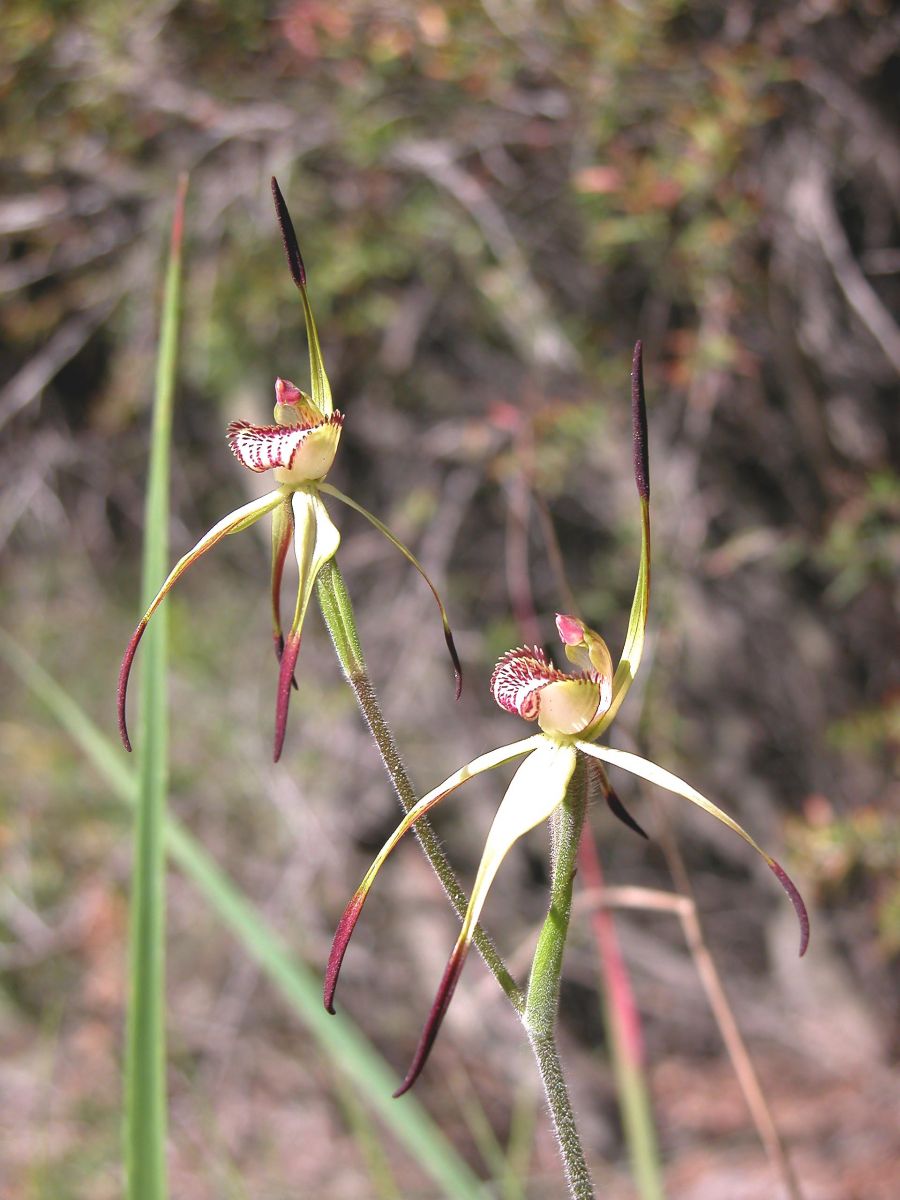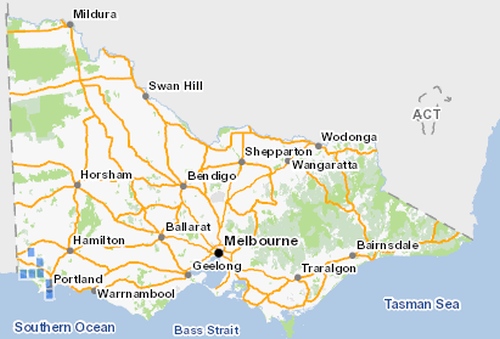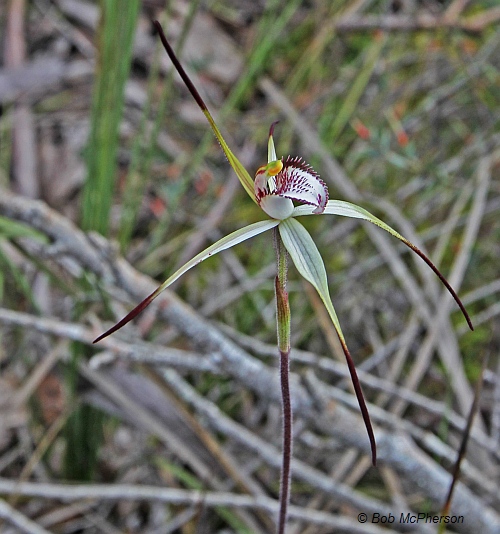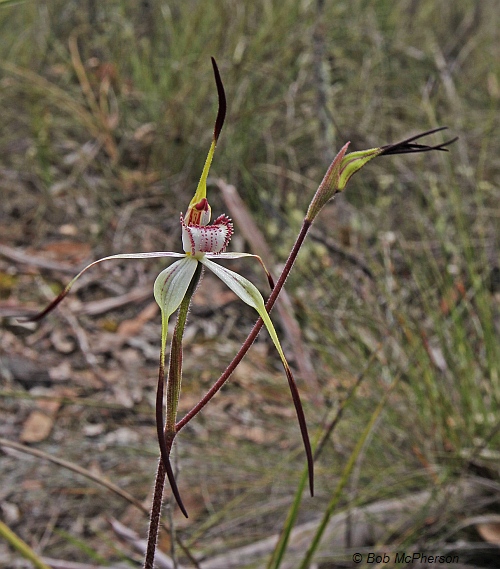Mellblom's Spider-orchid
Mellblom's Spider-orchidCaladenia hastata | |
|---|---|
| Kingdom: | Plantae |
| Phylum: | Magnoliophyta (Angiosperm) |
| Class: | Magnoliopsida (Monocotyledon) |
| Subclass: | Liliidae |
| Order | Orchidales |
| Family: | Orchidaceae |
| Status | |
| Australia: | Endangered (EPBC Act 1999) |
| Victoria: | Critically Endangered (FFG Threatened List 2025) |
| FFG: | Listed: Action Statement No. 103 |

Mellblom's Spider-orchid has creamy white flowers with dark red to black clubs at the tip of the petals and sepals. Flower stems are green to reddish colour and grow to approximately 35cm tall.
Distribution
Mellblom's Spider-orchid is confined to a small area of coastal heathland and heathy woodland in the Portland area of south west Victoria.
Flowering occurs between September and November, lasting about six weeks. Along with other spider-orchids, its flowers encourage wasp pollinators by mimicking the fragrance of a female wasp.

Threats

The decline of this species, like many others can be attributed to the loss of suitable remaining habitat through clearing and land developments. Introduced weeds compete for germination space and alter seed bed material, over grazing by rabbits and wallabies can reduce seed production whilst physical disturbance can remove root material or cause compaction resulting in unsuitable habitat.
Conservation & Management
The conservation status of Melblom's Spider-orchid was re-assessed from Endangered in 2013 to Critically Endangered in 2020 as part of the Conservation Status Assessment Project – Victoria (DELWP 2020).
Conservation of this critically endangered spider orchid has been an ongoing process for over 30 years. Actions are now performed through a recovery team and include propagation of plants for translocation, caging to protect plants from grazing and insect predation, using fire to promote plant regeneration as well as research, monitoring and surveys.
Management partnerships
- Parks Victoria
- Portland Aluminium (PA)
- Department of Environment, Land, Water and Planning
- Glenelg Hopkins Catchment Management Authority
- Local naturalists (Portland Field Naturalists Club, Casterton Threatened Flora Sub Group)
Update to 2016 on-ground actions relevant to all populations
Each year populations are monitored and orchids counted to assess population trends. An assessment is made of any threats to the populations and measures to control threats are implemented.
Works to control or restrict visitor access to populations are being carried out where a problem is identified.
The acquisition of baseline population data, including: identification of the areas and extent of the population; estimates of the number, size and structure of the population has been carried out for most sites.
There is now an improved understanding of the necessary disturbance regimes to promote regeneration and recruitment such as slashing and ground disturbance. Fine scale microhabitat enhancement is carried out at suitable sites to improve population recovery.
Seed has been collected from a range of populations for the orchid seed bank.
In 2011 the pollinator of Mellblom's Spider-orchid was identified as Lestricothynnus nr. vigilans, an undescribed thynnine wasp.
Conservation measures at specific locations
Bulleys Ranges, Lower Glenelg National Park - Parks Victoria
Protection of Mellblom’s Spider-orchid is now included in the Lower Glenelg National Park Management Plan.
Baseline population data, including: identification of the area and extent of the population; estimates of the number, size and structure of the population has been completed.
Monitoring of the populations are conducted annually.
Ongoing mosaic burning within Glenelg NP is carried out to maintain habitat, control weed invasion, stimulate flowering and encourage seedling establishment. These activities are undertaken within the Park Fire Management Plan.
Protect populations from fire prevention activities e.g. creating tracks near site.
In 2010 high priority areas were fenced to control browsing, including caging individual plants.
The establishment of new populations using collected seed is being investigated.
Fine-scale microhabitat management such as scattering leaf litter, seed-bed preparation, and scattering of seeds near parent plants is undertaken during late summer.
Cape Nelson State Park - Parks Victoria
A site known to support Mellblom's Spider-orchids has been included in the Cape Nelson State Park Management Plan.
Orchid seed is collected every year for propagation and the threatened orchid seed bank.
Hand pollination of plants is carried out when conditions suitable.
Baseline population data, including: identification of the area and extent of the population; estimates of the number, size and structure of the population has been completed. On-going monitoring of the populations are conducted annually.
Browsing has been controlled by caging individual plants.
Fine-scale microhabitat management such as scattering leaf litter, seed-bed preparation, and scattering of seeds near parent plants is carried out in late summer.
Removal of Coast Wattle is on-going.
Kent Bruck, Lower Glenelg National Park - Parks Victoria
A 7000ha wildfire burnt a large proportion of the Kentbruck Heath in March 2009.
Intensive surveys were conducted in 2013/14 in the burnt area in which a new population was found.
Annual surveys conducted with local enthusiasts to determine status of population.
Point Danger Managed by a committee of management
Hand pollination of plants was undertaken in 2012 with pollen exchange from a nearby site.
Seed has been collected from both artificially pollinated plants that will be used for in situ and/or ex situ germination measures in 2013.
The site has been included in the Point Danger Reserve Management Plan.
Protective cages have been placed over flowering plants each year.
Natural population has been supplemented by re-stock populations by hand seeding.
Fine-scale microhabitat management such as scattering leaf litter, seed-bed preparation, and scattering of seeds near parent plants is undertaken in late summer.
In 2011 the pollinator of Mellblom's Spider-orchid was identified as Lestricothynnus nr. vigilans, an undescribed thynnine wasp. The main threat to this wasp and in turn to Mellblom's Spider-orchid is the invasion of non-indigenous woody plant species, in particular, Acacia longifolia subsp. sophorae.
An ecological autumn burn was conducted within Point Danger Coastal Park in May 2013 to reduce woody weeds such as coastal wattle.
Portland Aluminium Smelter - Alcoa
A management plan agreement with ALCOA has been completed to protect the site.
Pollen exchange between Mellblom's at this site and a nearby site has been carried out. Seed has been collected from both artificially pollinated plants to be germinated for reintroduction.
Fine-scale microhabitat management such as scattering leaf litter, seed-bed preparation, and scattering of seeds near parent plants is carried out in late summer.
Browsing has been controlled by caging individual plants.
Wilkin Flora & Fauna Reserve - Parks Victoria
The intention is to protect Mellblom's Spider-orchid sites by inclusion in a reserve management plan.
In 2005 research was undertaken which helped to improve the understanding of the optimal conditions for growth of mycorrhizal fungi in-situ.
In 2010 studies confirmed the pollinator is a species of undescribed thynnine wasp Lestricothynnus nr. vigilans.
Hand pollination of plants and seed collection has been undertaken for propagation.
Some re-stocking was carried out in 2005 but no longer required.
Caging of plants was trialled in 2010 but discontinued.
Fine-scale microhabitat management such as scattering leaf litter, seed-bed preparation, and scattering of seeds near parent plants is considered in late summer each year.
Management of environmental weeds (pine wildings and has been identified as a high priority.

References & Links
- DELWP (2020) Provisional re-assessments of taxa as part of the Conservation Status Assessment Project – Victoria 2020, Department of Environment Land Water and Planning, Victoria. Conservation Status Assessment Project – Victoria
- EPBC Act (1999) Listing: Caladenia hastata, Species Profile & Threats Database, Department of Environment & Energy
- FFG Threatened List (2025) Flora and Fauna Guarantee Act 1988 - Threatened List - March 2025 Department of Energy, Environment and Climate Action (DEECA).
- FFG (2000) Flora & Fauna Guarantee, Victoria, Action Statement No.103, Twelve Threatened Spider-orchids Caladeina Species, 2000.
- VBA (2016) Victorian Biodiversity Atlas, Department of Environment, Land Water and Planning.

